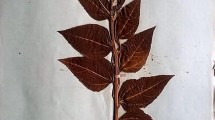Abstract
Kenaf,Hibiscus cannabinus L., occurs as a wild and ruderal plant in Kenya and Tanzania. It is polymorphic, varying in height, growth habit, spininess, flower color, and size of floral parts, capsules, and seeds. It occupies several distinct environmental niches, from low-lying meadows close to swamps and streams to semi-arid grassland /thornbush plains. It is also found in various weedy situations, such as cultivated and fallow fields, and fence- and hedgerows. At least one ecotype appears to be specifically adapted as a weed of cultivated fields. Leaves and stem-tips of this plant are used as food. It is not cultivated for this purpose, although it is sometimes encouraged in fields of maize, cassava, and perhaps other crops. It is apparently not used for fiber by the natives, possibly because fiber of the introduced sisal (Agave sisalana Perr.) is readily available everywhere. Kenaf fiber is produced commercially on a plantation in Tanzania, from a cultivar developed in Guatemala. The occurrence of twelve other taxa of Hibiscus section Furcaria in East Africa is discussed briefly.
Similar content being viewed by others
Literature Cited
Adamson, W. C., E. G. Stone, and N. A. Minton. 1974. Field resistance to the Javanese root-knot nematode in kenaf. Crop Sci. 14: 334–335.
Crane, J. C. 1947. Kenaf — fiber-plant rival of jute. Econ. Bot. 1: 334–350.
Deshpande, R. B. 1942. Inheritance of leaf lobe inHibiscus cannabinus L. Indian Jour. Gen. and PI. Breeding 2: 181–182.
Exell, A. W. 1961.Hibiscus, pp. 434–472.In: Exell, A. W., and H. Wild, Flora Zambesiaca, Vol. 1, Part 2. Crown Agents, London.
Hauman, L. 1963.Hibiscus, pp. 94–136.In: Robyns, W. (ed.), Flore du Congo Belge et du Ruanda- Urundi. I.N.E.A.C., Brussels.
Joyner, I. F., and J. B. Pate. 1956. The inheritance of leaf shape in kenaf. Jour. Hered. 47: 199, 204.
Menzel, M. Y., and F. D. Wilson. 1961. Chromosomes and crossing behavior ofHibiscus cannabinus, H. acetosella, andH. radiatus. Amer. Jour. Bot. 48: 651–657.
——. 1963. Cytotaxonomy of twelve species ofHibiscus sectionFurcaria. Amer. Jour. Bot. 50: 262–271.
——. 1969. Genetic relationships inHibiscus sectionFurcaria. Brittonia 21: 91–125.
Stephens, S. G. 1965. The effects of domestication on certain seed and fiber properties of perennial forms of cotton,Gossypium hirsutum L. Amer. Nat. 99: 355–372.
Wilson, F. D., and M. Y. Menzel. 1964. Kenaf (Hibiscus cannabinus), roselle (Hibiscus sabdariffa). Econ. Bot. 18: 80–91.
Wilson, F. D., and T. E. Summers. 1966. Reaction of kenaf, roselle, and related species ofHibiscus to root knot nematodes. Phytopath. 56: 687–690.
Wilson, F. D., T. E. Summers, I. F. Joyner, D. W. Fishier, and C. C. Seale. 1965. ‘Everglades 41’ and ‘Everglades 71,’ two new varieties of kenaf (Hibiscus cannabinus L. ) for fiber and seed. Fla. Agr. Expt. Sta. Cire. S-168, 12 pp.
Author information
Authors and Affiliations
Additional information
Contribution from ARS, USDA, Phoenix Arizona, in cooperation with the Arizona Agricultural Experiment Station.
Rights and permissions
About this article
Cite this article
Wilson, F.D. Wild Kenaf,Hibiscus cannabinus L. (Malvaceae), and related species in Kenya and Tanzania. Econ Bot 32, 199–204 (1978). https://doi.org/10.1007/BF02866873
Received:
Accepted:
Issue Date:
DOI: https://doi.org/10.1007/BF02866873




